
West Warwick is a town in Kent County, Rhode Island, United States. The population was 31,012 at the 2020 census.
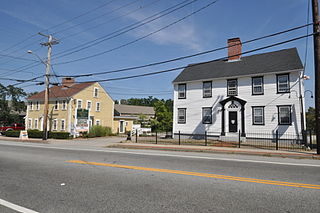
The Apponaug Historic District is a 2-acre (0.81 ha) residential historic district in the central village of Warwick, Rhode Island, which is also known as Apponaug. It consists of five properties dating to no later than the early 19th century. These houses are a remnant of what was once a much larger collection of period houses in Apponaug, many of which have succumbed to modern 20th-century development of the area.

Warwick Light, also known as Warwick Lighthouse, is an historic lighthouse in Warwick, Rhode Island.

The John Waterman Arnold House, home to the Warwick Historical Society, is an historic house at 11 Roger Williams Avenue in Warwick, Rhode Island. Built in the late 18th century, it is a two-story five-bay wood-frame structure with a central chimney, and a two-story ell extending to the rear.
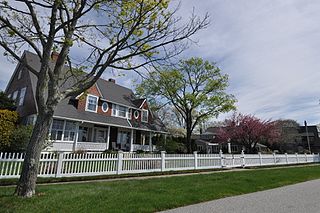
Buttonwood Beach Historic District is a historic district bounded by Brush Neck Cove, Greenwich Bay, Cooper and Promenade Avenues in Warwick, Rhode Island. Buttonwood Beach is a bucolic neighborhood on the eastern limb of the Nausauket neck, located in the West Bay area of Warwick, Rhode Island. Buttonwoods is delimited by Nausauket and Apponaug to the west, Buttonwoods Cove to the north, Greenwich Bay to the south and Oakland Beach to the east. Buttonwood Beach was founded as a summer colony in 1871 by the Rev. Moses Bixby of Providence's Cranston Street Baptist Church, who was looking for a place to establish a summer colony by the shore for his congregation. He envisioned a community that would be similar to Oak Bluffs on Martha's Vineyard, where the Methodists established a summer campground in 1835. Today, this coastal neighborhood on Greenwich Bay is home to people from many different religious backgrounds.

The Silas Clapp House is an historic house at East Greenwich Avenue in West Warwick, Rhode Island. The 2+1⁄2-story wood-frame house was built around 1797-1804 by Silas Clapp, who farmed a 100-acre (40 ha) parcel of land surrounding the house. It was thought to be built in 1804, but newspapers found in the walls are dated as early as 1797 and many at 1798, suggesting the house was built earlier than previously thought. It is a well-preserved example of vernacular Federal styling, with a five-bay main facade and a central entry with fanlight. There is a large central chimney, a feature more commonly found in older Georgian era homes. Descendants of Clapp owned the property until the 1880s.

Forge Farm is an historic farm in Warwick, Rhode Island. Established in the mid-17th century by the Greene family, it is one of the oldest farms in Rhode Island. It was the birthplace of General Nathanael Greene, a prominent American general in the American Revolutionary War. The core of the main house was built in 1684 by James Greene, son of John Greene, who purchased the land from local Native Americans. It has been extended and altered numerous times in the 18th and 19th centuries. Nathanael Greene was born in this house in 1742, and the farm was owned for many years by Nathanael's brother Christopher, and wife, Deborah (Ward) Greene, daughter of Continental Congress member Samuel Ward.

The Forge Road Historic District is a historic district on Forge Road from Ives Road to the Potowomut River in Warwick, Rhode Island. Most of the district's nearly 200 acres (81 ha) are taken up by the Forge Farm, which lies south of Forge Road, is one of the oldest farms in Rhode Island, and was the birthplace of American Revolutionary War general Nathanael Greene. A memorial to Greene stands near the bridge crossing the Potowomut River. Opposite the farm on Forge Road stand four houses, all of which date to the late 18th to mid-19th century.

Captain Oliver Gardiner House is a historic house prominently located in Warwick, Rhode Island. Built about 1750, it is a 2+1⁄2-story wood-frame structure with a gambrel roof. Its main facade has six irregularly-spaced bays, with a centrally positioned entrance. The house is unusual for its period in that it has a large central hallway, a feature not commonly seen until the Federal period. Oliver Gardiner, its first owner, was a ship's captain.
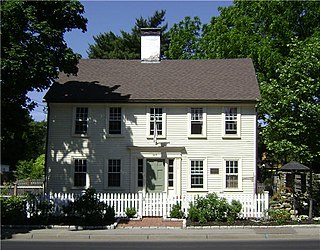
The Caleb Gorton House is a historic 18th-century house located in Warwick, Rhode Island.

The Caleb Greene House is an historic house in Warwick, Rhode Island.

The Moses Greene House is an historic house in Warwick, Rhode Island. It is a 2+1⁄2-story wood-frame house with a large central chimney, and a rear ell. The main block was built c. 1750, and is one of Warwick's few surviving 18th-century houses. It is located on one of the first sites to be occupied by European settlers in Warwick, near one of its first sawmills. In 1750, Moses Greene built his home where Buckeye Brook meets Mill Cove. The home may have served a role in the Underground Railroad—a secret cellar room is accessed by a stone wall that slides aside on iron tracks. The room may have also been used by rum smugglers. The house was listed on the National Register of Historic Places in 1983.

The Peter Greene House is a historic house in Warwick, Rhode Island. The 2+1⁄2-story wood-frame house was built c. 1751, probably by the sons of a militia captain named Peter Greene, and is a rare surviving 18th-century house in Warwick. It has a five-bay facade with a plain door surround, a central chimney, and a rear ell.

The Richard Wickes Greene House is an historic house in Warwick, Rhode Island. The 2+1⁄2-story wood-frame house was built in 1849, and is an excellent local example of Georgian style. Richard Wickes Greene was a ship's captain who acquired the property from the Wickes family in 1826.

The Greene–Durfee House is a historic house at 1272 West Shore Road in Warwick, Rhode Island. The house, a 2+1⁄2-story wood-frame structure with a large central chimney, stands set well back from the west side of the road, opposite Church Avenue and a small cemetery. It is set behind a small wood-frame commercial building and is partially screened from view by bushes. Built c. 1780, it is one of the city's finest Georgian style houses, with a particularly well-preserved interior.
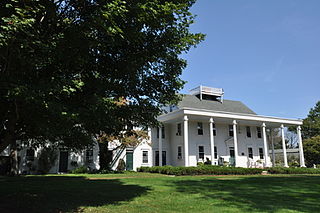
Hopelands is a historic country estate on Wampanoag Road in Warwick, Rhode Island. It is now the campus of the Rocky Hill School, a private college preparatory school. The historic centerpiece of the estate is a Colonial Revival mansion house, whose western ell is a wood-frame structure built in 1686. This house and its associated 75-acre (30 ha) property became the center of one of Warwick's first country estates, when in 1793 a Federal-style house was built by Thomas P. Ives and Hope (Brown) Ives, to which the old building was attached. This was given extensive Colonial Revival treatment in 1885 by Moses Goddard. The estate was acquired by the Rocky Hill School in 1948.
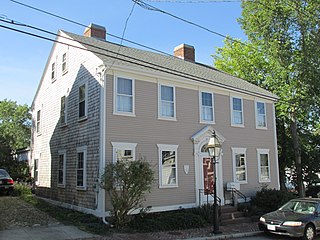
The Christopher Rhodes House is an historic house at 25 Post Road in the Pawtuxet village of Warwick, Rhode Island. The 2-1/2 story timber frame house was built c. 1800 by Christopher Rhodes, a prominent local businessman and cofounder with his brothers of the Pawtuxet Bank. The house was probably one of the finest Federal style homes of its time in the village, and is now one of the few to survive from that time. It has a side-gable roof, and is five bays wide with a center entry. The entry is topped by a fanlight and moulded architrave, and framed by Ionic pilasters.

The Oliver A. Wickes House is a historic house in Warwick, Rhode Island. The two-story stone structure was built in 1855 in a vernacular Federal/Greek Revival transitional style. The house is the only known period stone house in Warwick, and one of a very small number in the state. It has a four-bay main facade with a recessed entry framed by sidelights and a transom window.

The John R. Waterman House is an historic house at 100 Old Homestead Road in Warwick, Rhode Island. The 2+1⁄2-story wood-frame house was built c. 1800 by John R. Waterman, a prominent local farmer and politician. Waterman played a significant role in what became known as Dorr's Rebellion, an ultimately successful attempt to force liberalizing changes to the state constitution. The house is an excellent local example of Federal style, and is locally distinct for its use of paired interior chimneys instead of a large central one.

The Warwick Civic Center Historic District is a historic district encompassing three buildings at the civic heart of Warwick, Rhode Island.






















